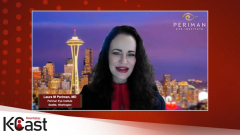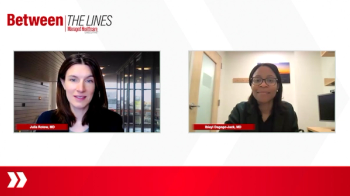
Navigating Breakthrough Pharmacologic Options for Treating Dry Eye Disease
Dr Laura Periman introduces current and upcoming pharmacological treatment options, including nasal varenicline, for patients with dry eye disease.
Episodes in this series

Laura M. Periman, MD: For a typical patient with dry eye, recommended therapies include all those lifestyle modifications and a quality preservative-free artificial tear. I wouldn’t call preservative-free artificial tears a treatment. They’re palliative. There’s a small amount of evidence that it helps over time, but it’s a slow boat, and we want to get these patients moving much faster. Understand that artificial tears shouldn’t be considered a treatment.
The immunomodulator options have expanded. We used to have only cyclosporine emulsion, Restasis. Now we have Xiidra and Cequa. There are other things coming, including a water-free formulation of cyclosporine. We were a phase 3 clinical research site for that. It has phenomenal tolerability, which is important because some of the immunomodulators we have are faced with problems regarding tolerability and formulary access. We’ll soon have more treatment-delivery options. This water-free one is very exciting. The water-free vehicle for cyclosporine is also being developed by Bausch + Lomb. We were a trial site for that as well. I’d call that a treatment because of what we saw in the clinical research studies.
When you’re talking about the offerings of immunomodulatory therapy—Restasis, Xiidra, and Cequa—there are occasions when I have very specific reasons for wanting any one of those. That runs up against formulary coverage with some third-party payers. That’s frustrating because there are times when a patient needs a specific one. Moving ahead, patient selection should be prioritized over what’s on the formulary. For example, Xiidra [lifitegrast] is uniquely beneficial in a patient with any kind of an allergic conjunctivitis component and any component of lid inflammation, blepharitis, meibomian gland dysfunction [MGD], because the drug gets higher tissue penetration than Restasis does. Conversely, Cequa is a higher concentration of cyclosporin, and the drug-delivery innovation means that the drug concentration is threefold higher in the cornea and conjunctiva. That’s important for efficacy and tolerability. All these things have variances in which patient tolerates what.
Looking ahead at the innovative pipeline, as we get more of these tools on board, we’ll have more options to get around tolerability, safety, and efficacy issues for an individual patient situation. But there are also some paradigm-shifting things coming about. We’re particularly excited about the anti-Demodex medication. The phase 3 study just finished. They announced their top-line data this week. That treats Demodex, which is present in 50% to 60% of patients with blepharitis, MGD dry eye. This medication creates eradication. It will change the landscape in polypharmacy because it’s targeted, specific, and direct at what that main contributor is. That will translate into efficiencies for the patient, clinician, and third-party payer. I’m very excited about these options.
Other technologies that I often use include neural stimulation. At the beginning, we talked about neurosensory compromise, that electrical wiring and short-circuiting in control of a homeostatic stable tear film. We have 2 methods for addressing it. One is an extranasal vibration stimulation device, and the other is an intranasal varenicline nasal spray. Both are highly effective. We were a phase 3 trial site for both those modalities, and they function about the same. We’ve published on this. We’ve presented on this helpful modality for patients with dry eye. It helps to orchestrate a physiologically complete tear film. As these innovations come about, I don’t want to see fearfulness of them. I want to see them viewed as targeted and specific for the right patient, which translates into efficiencies.
How does neural stimulation work? As we talked about, that electrical wiring is offline and, in short, the corneal nerves are constantly sensing the quality of the tears. There’s a message to the central nervous system, integration of that message, and then command to the glaucoma gland, the meibomian glands, and the goblet cells. It’s paramount to get those meibomian glands and goblet cells as healthy as you can. It’s paramount to get the lacrimal gland protected with your immunomodulators. Now you can come along and orchestrate the song through neural stimulation.
It turns out that we achieve this through the trigeminal nerve. The trigeminal nerve is the largest corneal nerve in the brain. It services your face as well as corneal sensation. By stimulating a branch of the trigeminal nerve, this nasociliary nerve, you can achieve a backdoor approach to adjust the quality of the tears. You can see this happening in real time. There are videos on my website, dryeyemaster.com. Look for the neural stimulation demonstration. When a patient uses the intranasal spray, you can see the tear volume coming up and their blink frequency go from split blinking because it’s painful to a normal pattern in the chair in the light. It’s a powerful modality for stimulating and orchestrating a physiologically complete tear that no artificial tear can do. The native tear that you’re stimulating has 2000 molecules of corneal comfort and nutrition awesomeness. There’s no artificial tear that can come anywhere close to the tear that Mother Nature designed.
Transcript edited for clarity.
Newsletter
Get the latest industry news, event updates, and more from Managed healthcare Executive.


















































